There are some horses that are naturally really hot and nervous, and even after they’ve been taken through the Fundamentals groundwork and riding exercises and the foundation trail exercises, they still have a lingering desire to be in a hurry everywhere they go. This is the off-the-track Thoroughbred that starts and ends a 20-mile trail ride at a power walk. Or the ex-barrel racer that swings his head from one side of the trail to the other, constantly eyeing up his environment, just waiting for a mountain lion to jump out of the brush. Or he’s the Quarter Horse that’s a saint as long as you’re training on him, but the minute you put him on a loose rein, he speed walks down the trail and chomps on the bit.
These horses require a little extra training and patience. The fix is not to force the horse to calm down and relax, but to turn your idea to slow down into the horse’s idea.
Hurrying to Work
All over the ranch, I’ve constructed “rollback fences.” These are 6-foot high gate panels set in front of a 45-foot dirt circle. The purpose of the fences is to be able to train on horses while riding them on the trail. Instead of just doing rollbacks in the middle of a dirt road, these fences make it easier to direct a young or green horse through the maneuver. While you might not have such a training tool at your disposal, you can implement the same training plan I describe by incorporating natural obstacles.
When we get a hot-blooded, busy-minded horse with a severe problem in the Academy Horse Program, we spend several training sessions riding the horse from one rollback fence to another. We start the training session as we do every training session—by practicing at least half an hour of groundwork to ensure the horses are using the thinking side of their brains and are tuned in to us. Then we get in the saddle and spend a few minutes flexing them at the standstill. Then we spend some more time bending them around in a circle and softening their bodies.
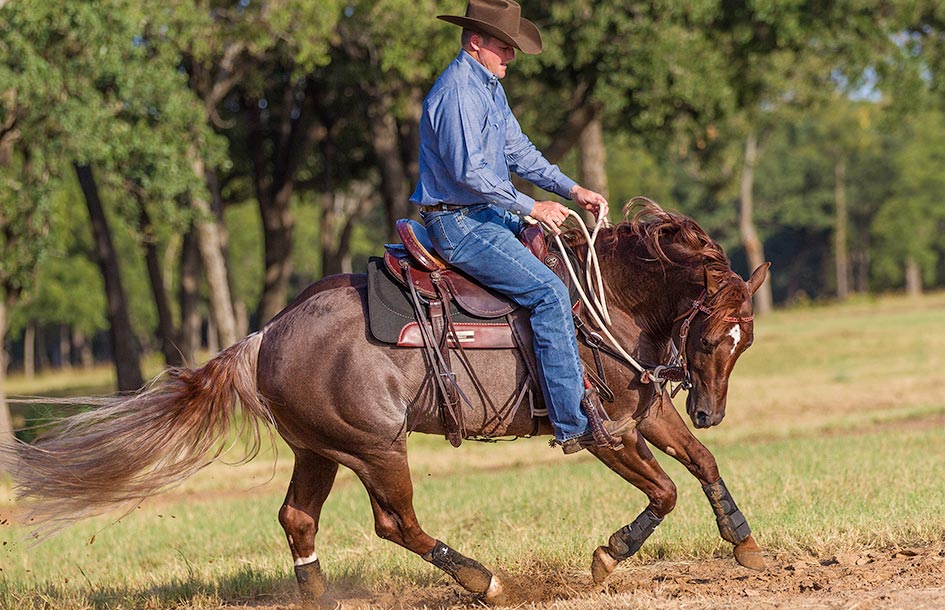
There are some horses out there that are so full of energy and constantly worried about their environment that you’ll have to take this extra step in their training to get them to calm down and relax.
One of the rollback fences is located near where we typically get on the horses, so after we warm them up, we go put their feet to work doing rollbacks on the fence. I’m using rollbacks as an example because they’re one of my all-time favorite training exercises, but as long as you’re hustling your horse’s feet and constantly changing directions, it doesn’t matter how you’re working the horse, just that you are assertively moving his feet. You can do serpentines, counterbend the horse, etc.
Even when I’m working the horse at the rollback fence, I don’t just do rollbacks. I practice Bending Transitions, I yield the horse’s hindquarters, I trot him in serpentines, etc. I keep him guessing about what I’m going to ask him to do. If I only practiced rollbacks at the fences, the horse would eventually start anticipating rolling back next to the fence. And since you’re already dealing with a hot-blooded, busy-minded horse to begin with, a lot of these horses also start to get nervous about the rollback. So I constantly mix up how I ask the horse to move his feet at the fence.
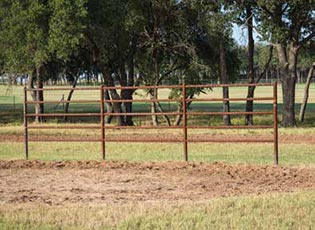
I’ve placed rollback fences like this one all over the ranch so that we can train on our horses whenever the opportunity arises.
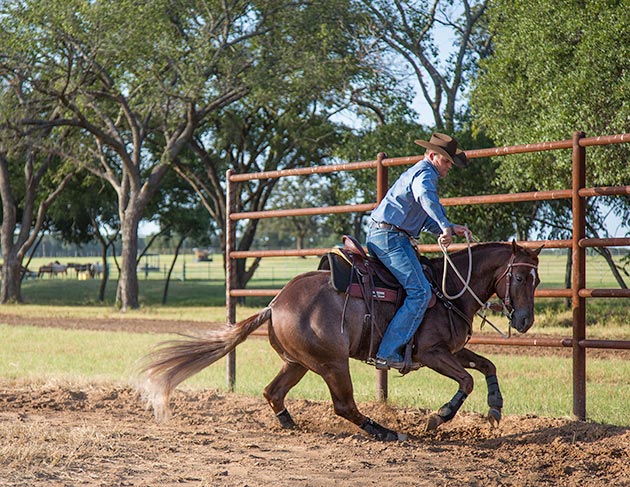
After warming the horse up, I hustle his feet at the rollback fence for five to 10 minutes. The more busy-minded the horse is, the longer I work him at the fence.
We work the horses for five to 10 minutes. The length of time depends on how hot it is, how athletic the horse is and how busy-minded he is. The hotter the temperature, the shorter the session, and the more athletic and busy-minded the horse is, the longer the session. Then we put the horse on a loose rein and walk him down the trail to the next rollback fence. The fences are about a half mile apart and take several minutes to walk to. As a general rule, you want to let the horse walk for about five minutes between workouts. The walk is the relaxing part of the ride for the horse—he gets to be on a loose rein and get his air back. While the horses are walking down the trail, we rub on them. But the key is to let the horse walk on a big, loose rein and not do any sort of training whatsoever on him. Hold the middle of the reins in one hand and let him be. At first, when you put the horse on a loose rein, he’s going to power walk down the trail. That’s fine. Even if he wants to trot or lope, let him. Remember, you’re not forcing the horse to relax and slow down; you’re just going to show him that it’s the better option.
When we get to the next rollback fence, we put the horse’s feet to work, rolling him back into the fence. We repeat the exact same thing we did at the first fence— we keep the horse’s feet moving for five to 10 minutes and then put him on a loose rein and walk down the trail again. It usually takes until the third or fourth rollback fence for the horse to finally realize that there’s no point in rushing down the trail because he’s only hurrying to hard work and sweat. It’s like something just clicks in his brain and he starts walking more slowly and his mind stops racing a million miles a minute. Make no mistake about it; it takes a lot of energy and air for a horse to practice rollbacks for five or 10 minutes. While the horse might think it’s fun to speed walk down the trail or jig, when he has to move his feet under your direction, it loses all its fun.
Remember, horses are basically lazy creatures and would always rather stand still and sleep rather than have to move their feet and sweat. This exercise— walking the horse from one rollback fence to another— would be like if I had you walk 500 feet and then made you do 50 pushups. After you finished the pushups, I’d have you walk another 500 feet. After three to four repetitions of that, you’d start walking slower and slower between pushup sites because you’re not looking forward to doing the exercise.
Hot, busy-minded horses think five miles down the road. They don’t even realize you’re on their back. You want your horse thinking 3 feet in front of his nose. You’ll rarely get in trouble on a horse that’s tuned in to you, but I guarantee you’re riding toward a wreck if you let your horse’s mind get ahead of you.

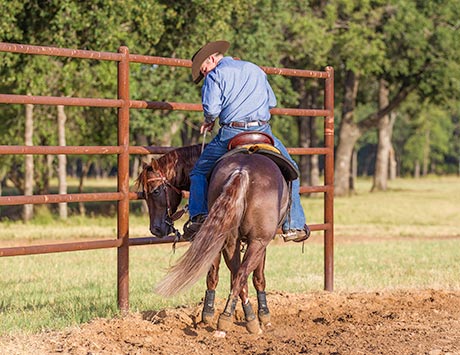
Even though I work the horse at the rollback fence, I don’t just practice rollbacks with him. I’ll throw in some bending transitions (left) and yield his hindquarters (right). I don’t want the horse to anticipate just rolling back or to tune me out. I want his attention on me.
Stay at It
As a general rule, you should work your horse at five locations at the bare minimum. You’ll probably notice a change in the horse at about workout location number three, but it’s important to keep at it to be sure he’s mentally and physically relaxed. (In fact, for the best results, you’ll practice this training session for five to seven days in a row.)
The biggest mistake people make with hot, busy-minded horses is never teaching them how to relax and use the thinking side of their brains. It’s not possible for a horse to relax when he’s nervous, anxious and using the reactive side of his brain. What happens, though, is the horse will power walk down the trail or jig and instead of the rider moving the horse’s feet to get him to use the thinking side of his brain, they ignore his behavior or try to slow him down with two reins. Then, at the end of the trail, they get off him and unsaddle him and put him away. They don’t even realize it, but they’re teaching the horse that his reactive, nervous behavior is acceptable and normal.
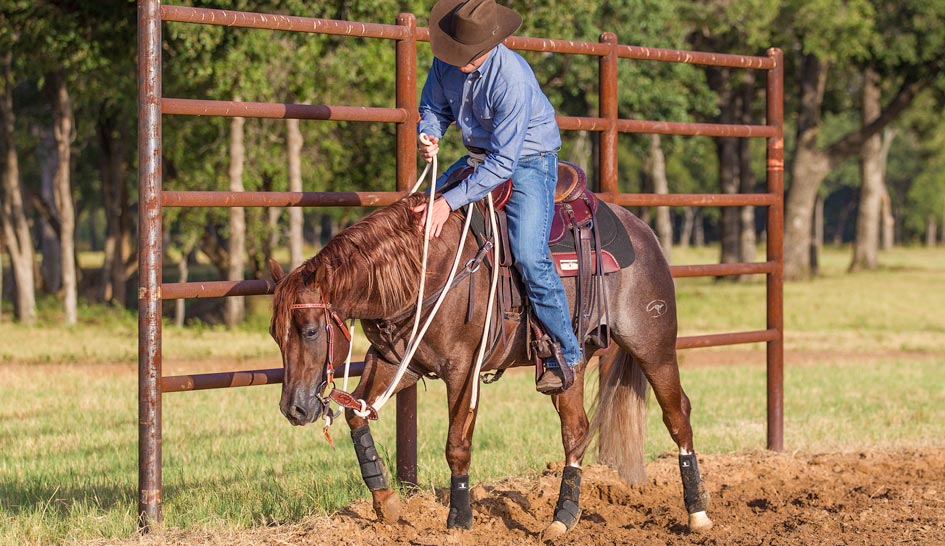
After hustling the horse’s feet, I put him on a loose rein and walk him to the next rollback fence. Between fences, I do not do any training on him whatsoever.
The Most Important Session
While each area where you work your horse’s feet is important for his training, the pivotal training session will take place at the barn or wherever you saddle and unsaddle your horse. If you bring the horse home and immediately unsaddle him, you’ll create an even worse problem—a hot, busyminded horse that wants to rush home. Horses aren’t stupid; they know where they get to rest.
Just as before, you’ll work the horse’s feet for five to 10 minutes, constantly asking him to hustle and change directions. I like to end this last training session by backing the horse up, because it really gets those hot horses that are always thinking “forward, forward, forward” to think “get back” for a change. It’s a good way to finish off the entire training session.
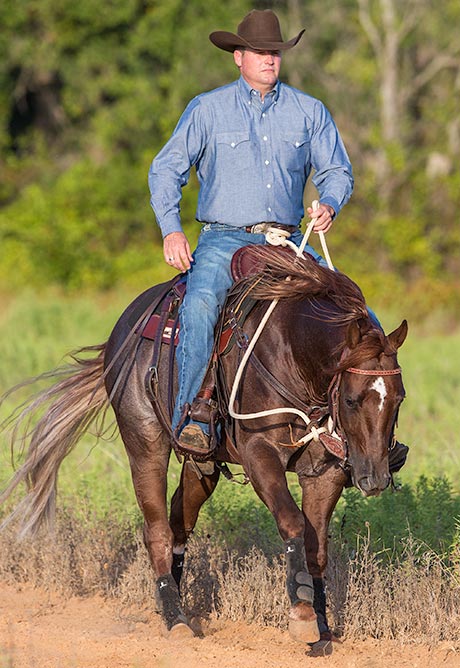
If the horse chooses to trot or lope, and most will at first, let him. He’ll soon realize that he’s just rushing to hard work.
Consistency Is Your Ally
For this lesson to really change the horse’s frame of mind so that he learns to relax and use the thinking side of his brain, you should practice these training sessions for five days in a row. The second day you bring your horse out, he’ll start out power walking between the first couple of workout locations. But then he’ll relax and slow down. It’ll take less time to get him to use the thinking side of his brain than it did the first day. When you’ll really start seeing the results of these sessions is on day three. More than likely, your horse will start the ride out relaxed and slow.
If you’re smart, you won’t stop there. You’ll practice these training sessions at least two more times to get that “relaxed and slow” mentality ingrained in the horse. Then you can go back to training your horse on the trail as normal. But it’s important that for the first few sessions you not train on the horse at all except at the workout locations. You want it to be really clear for the horse: Regardless of where we’re going, it’s never a fun place to get to. It doesn’t matter which direction we go in or how far we go, there’s always hard work when we get there, so you might as well take your time and enjoy the downtime between. Horses are simple creatures, so you have to keep your training simple to make the most progress.
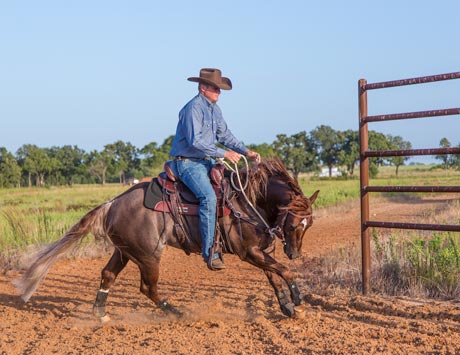

After you’ve let the horse walk for about five minutes, put his feet to work again. The rollback fences on the ranch are roughly a half mile apart, which is the perfect distance to let the horse relax and get his air back before hustling his feet again.
Success Tip: Calling out.
Oftentimes, busy-minded horses are guilty of sending shrill whinnies up and down the trail, hoping to hear a response from another horse. From anxious whinnies to gusty neighs, horses’ voices carry very well, which can attract a lot of unwanted attention.
When your horse whinnies, he’s telling you in big bold letters that his attention is not on you. A horse that is focused on his rider and the job at hand does not have time to be calling out. It’s a clear sign that you’re not engaging him enough and getting him to use the thinking side of his brain.
When you’re on a horse that’s anxious and unsure, get his feet moving. Train on him. Practice Bending Transitions. Two-track him. Sidepass up and down the trail. Use your imagination to get him to focus on you and not his unease.
When you first take a horse away from home, it’s common for him to be nervous and call out to other horses. For the most part, when this happens to me, I ignore it. I just focus on training the horse, because I know once I get him moving his feet forwards, backwards, left and right, he won’t have time to be worried about his buddies. In that way, the problem disappears on its own.
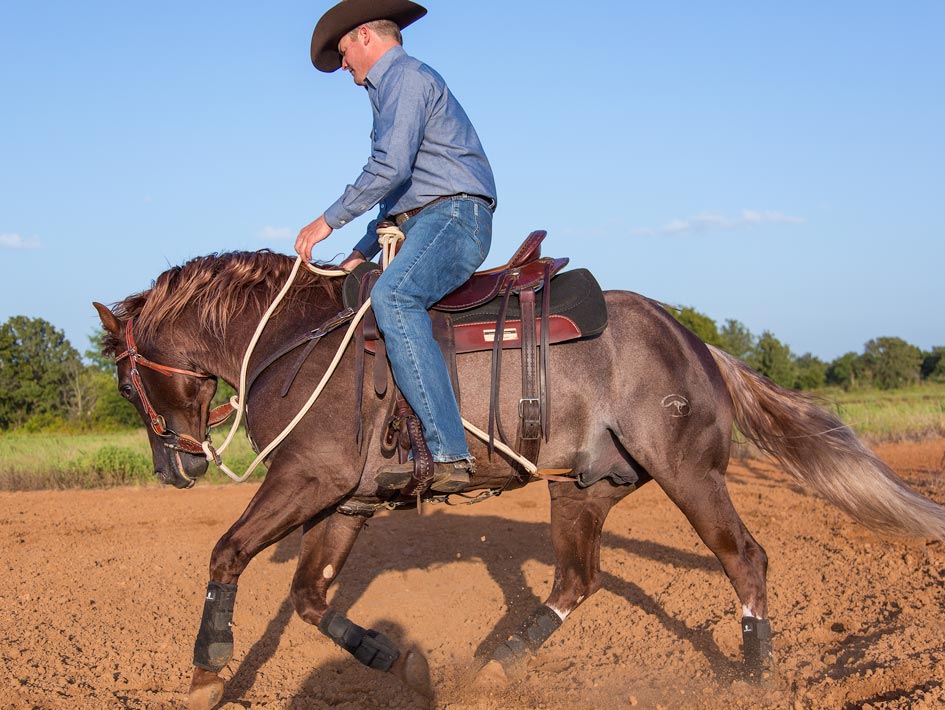
Hot, busy-minded horses think five miles down the road. You want your horse to think 3 feet in front of his nose.
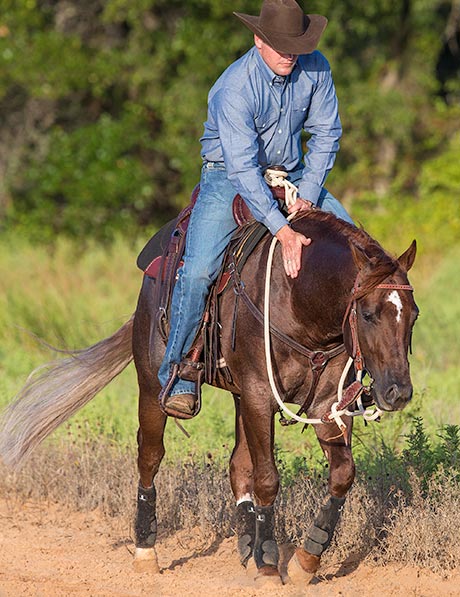
The key to success with this exercise is making sure you let the horse walk on a big, loose rein and rub on him for at least five minutes between training sessions. A busy-minded horse needs to learn to relax and enjoy walking.
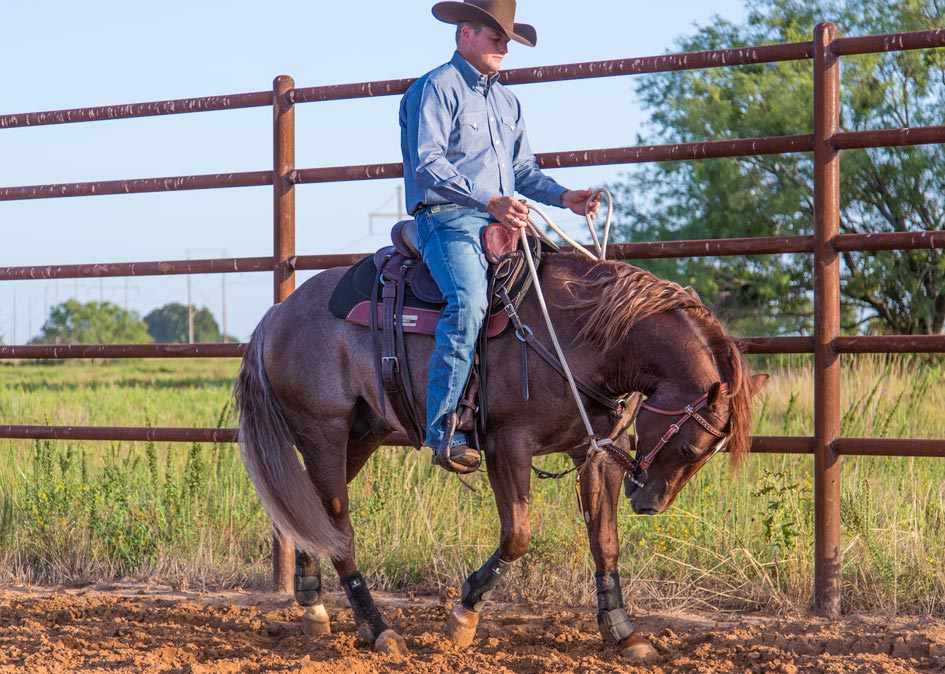
Because a busy-minded horse always has “forward” on his brain, finish the session by asking him to back up.
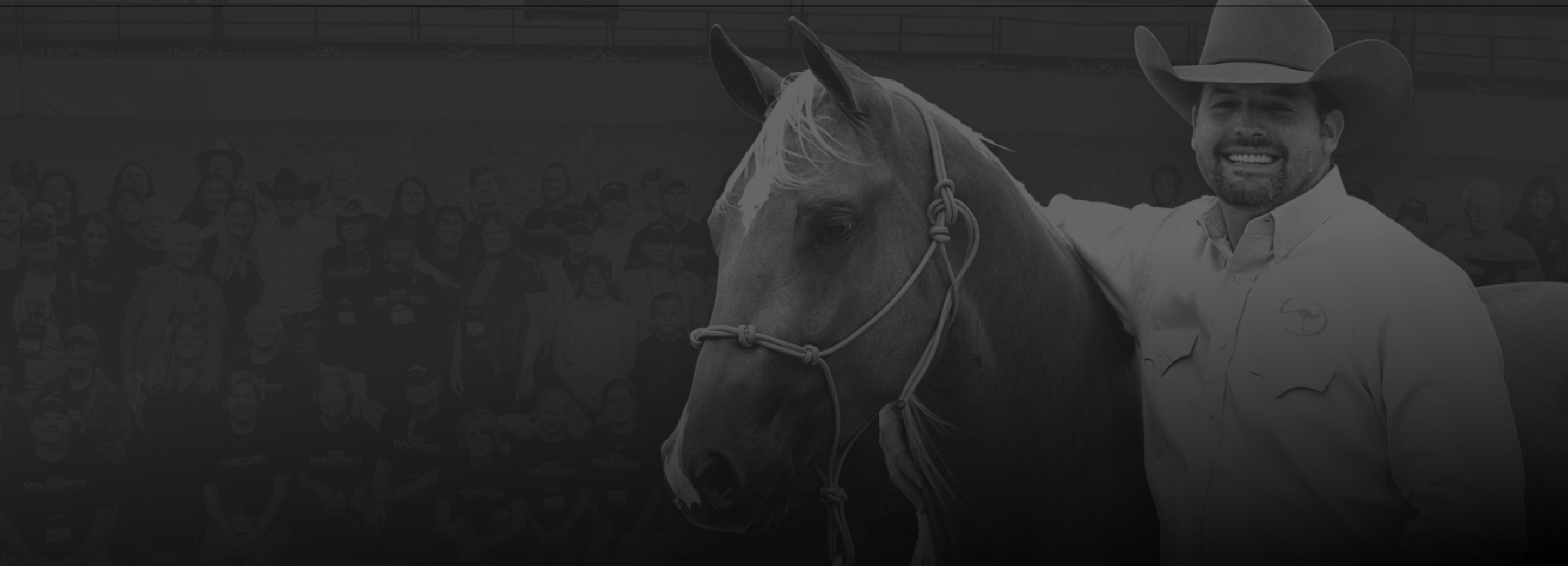
Want To Learn More? SIGN UP FOR OUR LOYALTY PROGRAM
Master your horsemanship training through Clinton’s step-by-step method videos by joining the No Worries Club today. Becoming a club member ensures you get VIP pricing on all of Clinton’s must-have training tools and resources. Plus, you’ll enjoy all the phenomenal benefits that come with club membership!



